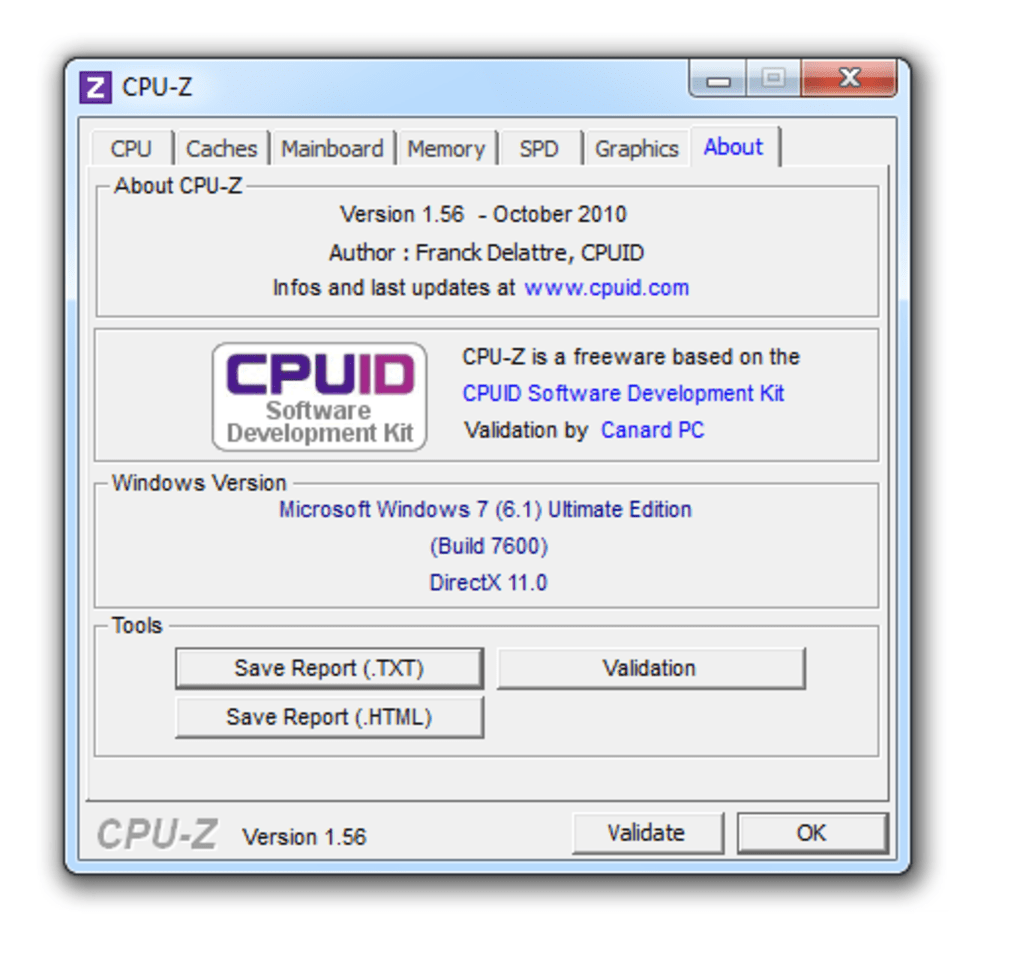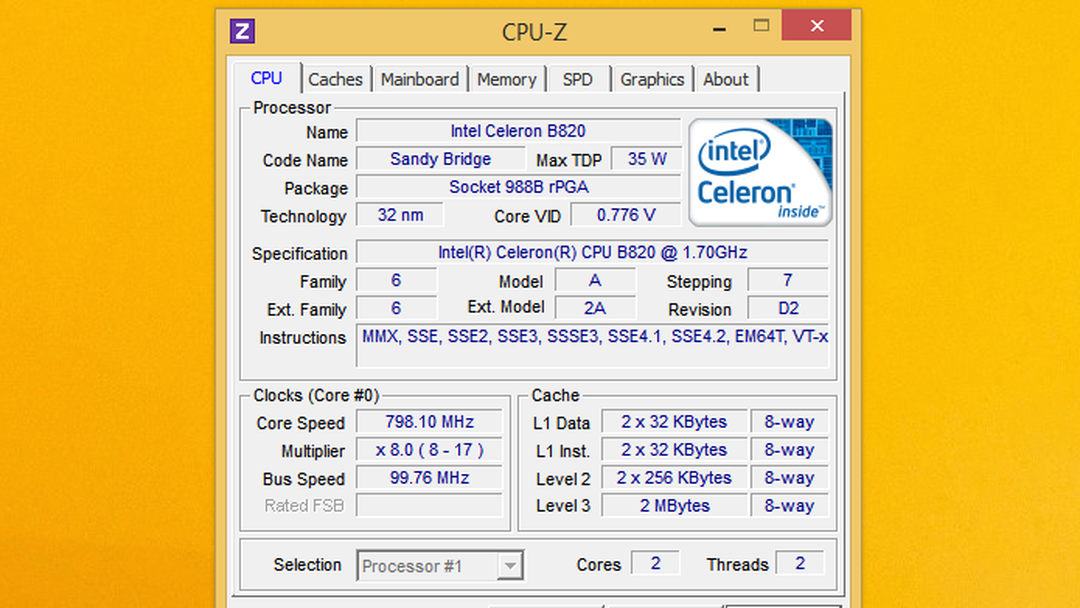(Credit: Apple)
CPU-Z yields an impressive data sheet of a computer system's functions and operations. By cutting out a lot of technical and manual searching, this handy freeware generates a list of information. CPU-Z is a freeware that gathers information on some of the main devices of your system: Processor name and number, codename, process, package, cache levels. Mainboard and chipset. Memory type, size, timings, and module specifications (SPD). Real time measurement of each core's internal frequency, memory frequency. The CPU-Z‘s detection engine is now available for customized use through the.
After 15 years and approximately 50 failed predictions, Apple has finally announced its own ARM CPU for the Mac and MacBook product lines. The upcoming A12Z will transition Apple away from the x86 CPUs it adopted in 2005 and move the entire macOS and iOS software stacks to hardware Apple can control. As a side benefit, Macs will also be able to run iOS applications natively, once the ARM hardware actually ships.
Apple, true to form, didn’t release much in the way of technical data or performance metrics. But the company did talk about its plan for the ARM transition and what changes it is making to its macOS and software support to enable it.
In macOS 11.0 (Big Sur), all Apple-created applications will be native apps. There’s a new type of universal binary, dubbed Universal 2, that will run on both Apple and x86 hardware. Apple’s entire goal is to deliver desktop-level performance in notebook power consumption, which sounds impressive until you think about just how wide the range of desktop and laptop power consumption actually is.
The blue-highlighted area in Apple’s graph is larger than either the “Desktop” or “Laptop” box. The company is giving itself some wiggle room as far as where the new parts will fall, and how they’ll compare to previous chips, while still forecasting a general improvement. PCMag reports that the actual differential could be enormous. Analyst Ming-chi Kuo believes Apple will introduce a 13-inch MacBook Pro with performance 50-100 percent above an equivalent Intel CPU, powered by a 12-core processor. Cost savings are supposedly in the 40-60 percent range. Both of these would be enormous improvements, but the claimed gain is large enough to take with a grain of salt.

Apple showed off multiple application builds at the event, including Photoshop, Final Cut Pro, Word, and Excel all running on Apple silicon. Developers will be able to port their applications seamlessly, but apps that aren’t ported will still run in emulation using a dynamic just-in-time system named Rosetta 2. No word on what the performance hit for emulating in this fashion is, but we don’t expect miracles.
Good emulators make running code written for a different architecture tolerable, even reasonable, but there’s an inevitable latency and performance impact when performing code translation. Apple’s 68k-PowerPC jump is legendary for providing faster emulated performance than native code could deliver, but the gap between x86 and ARM isn’t nearly wide enough for Apple to pull off the same feat.
Apple’s hope, obviously, is that as many developers as possible will port their code to avoid this problem, and the company did show Maya running fluidly via Rosetta 2. But it didn’t show the application actually performing any model loads or rendering final output — and those are the steps likely to hit the CPU the hardest.
Apple is launching a quick start program for developers that want to get working on the A12Z silicon. The dev kits will ship in a Mac Mini chassis with 16GB of RAM and a 512GB SSD. No data was provided on GPU performance, either, so the GPU is essentially a black box. Systems are expected to ship by the end of the year, but the transition period is longer than expected, at a full two years.
This isn’t a trivial delay, and it says something about how much additional work Apple still needs to do to fully transition its entire Mac product stack. At a guess, the company will handle the MacBook and iMac first, but the Mac Pro is going to be a heavier lift. If we had to guess — and at the moment, we do, because Apple isn’t giving out the details — we’d expect the company to try to take x86 out of the highest-end workstations after it pushes the technology out of mobile and desktop systems.

I didn’t expect Apple to give us more than it did, but I wish the company had. Right now, the performance question isn’t much clearer than it was before the keynote aired. Obviously Apple expects improvement or it wouldn’t have gone through with this initiative in the first place. The question is, how much?
Now Read:
WhatsaByte may collect a share of sales or other compensation from the links on this page.
CPU-Z is a free detection program for Microsoft’s Windows, which helps gather system information and then shows the details on a single screen. It’s developed by CPUID, and updated on a regular basis, supported most of processors & chipsets.
If you don’t intend to view detailed information about the hardware of your computer, you might sometimes want to know what kind of processor or how much RAM your PC has. As for instance, do you know the sort of your RAM or its bus speed? It’s important in the case of upgrading your PC to add more RAM.

So, do you want to learn more about CPU-Z? Like where to download it, and how to use it, as well as read the information from this free detection tool.

Download The CPU-Z Portable Version
As I mentioned above, CPUID updates this tool regularly to add more features and supports for new CPUs and chipsets. The good news is that it’s available as a portable version, which you can download and run – no need to install.
But if you don’t want to use the portable app, there is also a version for you to download and install. No matter which version you have selected, visit the official website here to download.
How To Use CPU-Z To View Your PC Information
Well, the interface of CPU-Z is simple and very easy to use. After opening the tool, it automatically scans all of your hardware and then returns the information back to the screen of the tool.
The first tab is to show CPU information, as seen below. From there, you can view processor name, how many cores & threads, code name, socket, max TDP, technology, clock speed, cache and much more. If you are using two processors in one mainboard, there is a drop-down menu to select “Processor #1” and “Processor #2“.
The second tab is the “Caches” tab that shows L1, L2 and L3 cache of your processor.
The “Mainboard” is the third tab, where displays all of the details about your mainboard, as well as current BIOS version. This is where you need to go and find your BIOS version before updating the BIOS of your mainboard.
Also, know and remember the exact manufacturer and model of your mainboard is useful because it helps to find latest drivers easier.
Read Article: How To Fix Err_SPDY_Protocol_Error In Google Chrome
The “Memory” tab is also helpful for most of the users, who are planning to upgrade their PC and add more RAM. In the image below, you can see that my desktop computer has a total of 16 GB of RAM memory. The type of memory is DDR3, and it’s running in the dual-channel mode.
Most of the other details are for advanced users. You don’t need to remember them unless overclocking. For further details about each RAM slot, such as manufacturer, module size, part number and timing information, read it in the “SPD” tab.
If you want to find out information regarding your graphics card, take a look at the “Graphics” tab. From there, you only can view a few basic information, such as GPU name, manufacturer, technology, clock speed and memory size. If you want to see detailed information about your graphics card, you should use GPU-Z, which better.
Cpu X
Read Article: How To Fix 0xc000000f Error While Booting Your Windows PC
Cpu Z For Macbook
There is a “Bench” tab in CPU-Z that allows you to do a benchmark for your CPU and then compares to other CPUs. Do you want to try it?
There is also a version of CPU-Z for Google’s Android. If you want to see hardware information about your Android smartphone or tablet, download the app from the Google Play store.
Cpu-z Download Free For Mac
If you have any questions about CPU-Z, let me know by leaving your comment below.

